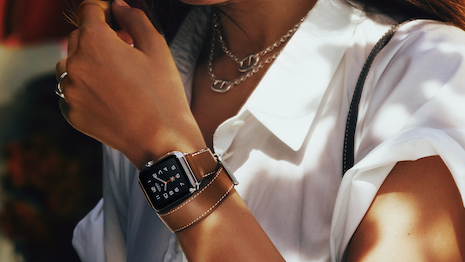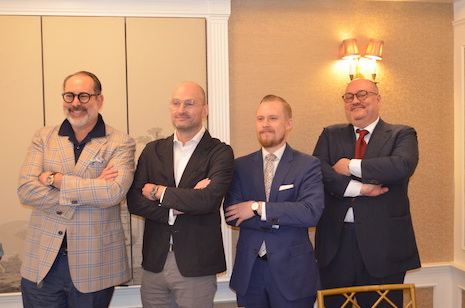 The Apple Watch and iPhones have been associated with luxury goods for years. Image credit: Hermès
The Apple Watch and iPhones have been associated with luxury goods for years. Image credit: Hermès
NEW YORK – Rather than rendering classic watches obsolete, technology-focused timepieces have instead opened consumers up to the idea of investing in what they wear on their wrists.
During a panel discussion hosted by the Madison Avenue Business Improvement District on June 11, coinciding with the retail thoroughfare’s Watch Week, speakers talked about how smartwatches and mechanical watches coexist in consumers’ wardrobes. While releases such as the Apple Watch may have hurt sales of fashion timepieces, they have actually been a boon to brands such as Rolex, getting consumers accustomed to wearing and relying on a watch.
What to watch
Panelist Reginald Brack, watch and luxury industry analyst at NPD, noted that it is only a small percentage of consumers who say that owning a smartwatch would prevent them from purchasing an analog timepiece.
Consumers also often wear both smartwatches and traditional watches at the same time, donning one on each wrist. William Massena, managing director of watch forum Timezone, said he wears his Apple Watch daily, despite also having a penchant for mechanical watches.
Sales of smartwatches were up 54 percent in 2018, contributing to a 13 percent rise in overall watch sales throughout the year, according to data from NPD Group.
While traditional timepieces accounted for more than half of sales during the year, smartwatches took the lead in the last quarter with 55 percent of all spending. Luxury watchmakers have increasingly been launching tech-driven watches as consumers seek more than analog features (see story).
Panelists Aaron Sigmond, Reginald Brack, Ville Santaharju and William Massena. Image courtesy of Madison Avenue BID
When it comes to collecting, watch enthusiasts take different approaches. Mr. Massena stocks up on a particular timepiece he falls in love with, buying multiples.
Other watch collectors might focus on flipping, taking more of a commoditized view on it. Mr. Brack noted that when he was at Christie’s, consumers would buy and sell timepieces in a short timeframe as they reconsidered what they wanted to hold onto and moved through phases of interest.
The analyst cautioned against looking at watches as a monetary investment, since their resale value can often be difficult to gauge.
One trend in the watchmaking world is direct distribution. Moderator and author Aaron Sigmond noted that companies are looking to control more of their retail operations to give themselves more control over the messaging and product.
Meanwhile, some watchmakers such as Patek Philippe and Rolex are closing doors to focus on their most productive locations, said Mr. Brack.
An aspect that separates bigger brands from smaller houses is the amount of handwork that goes into the watchmaking. Whereas a Rolex might make about 1 million timepieces per year, a watchmaker such as A. Lange & Sohne only makes about 5,000 in the same time frame.
Ville Santaharju, master watchmaker at A. Lange & Söhne, noted that the brand is known for its hand finishing.
The panel was hosted by Madison Avenue BID as a kickoff to Watch Week, which is supported by the Wall Street Journal and the Horological Society of New York. From June 10 to 15, consumers can visit participating stores from Apple to Jaeger-LeCoultre to view timepieces from Baselworld and Salon International de la Haute Horlogerie.
Watch boutiques will also be hosting events such as master classes and cognac tastings.

